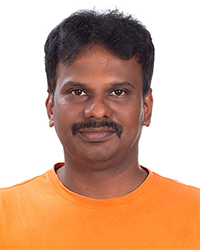P408
886-2-2789-8335
sankarraman [at] gate.sinica.edu.tw

P408
886-2-2789-8335
sankarraman [at] gate.sinica.edu.tw
周泳恩 / 886-2-2789-8364
michelle0831[at]gate.sinica.edu.tw
| (1) | 國內學術研究獎項 | 2022 | Plum Blossom Card - Senior Skilled Talent Research |
| 主要相關著作: |
| Bayikadi Khasim Saheb, Imam Safdar, Tee Wei-Shen, Kavirajan Sugumaran, Chang Chiao-Yu*, Sabbah Amr, Fu Fang-Yu, Liu Ting-Ran, Chiang Ching-Yu, Shukla Dinesh, Wu Chien-Ting, Chen Li-Chyong, Chou Mei-Yin, Chen Kuei-Hsien, Sankar Raman*, 2024, “Ultra-low lattice thermal conductivity driven high thermoelectric figure of merit in Sb/W co-doped GeTe”, Journal of Materials Chemistry A, 12(44), 30892-30905. (SCIE) (IF: 11.9; SCI ranking: 14.9%,9.1%,9.3%) |
| 主要相關著作: |
| Frank Y Gao, Xinyue Peng, Xinle Cheng, Emil Viñas Boström, Dong Seob Kim, Ravish K Jain, Deepak Vishnu, Kalaivanan Raju, Raman Sankar, Shang-Fan Lee, Michael A Sentef, Takashi Kurumaji, Xiaoqin Li, Peizhe Tang, Angel Rubio*, Edoardo Baldini*, 2024, “Giant chiral magnetoelectric oscillations in a van der Waals multiferroic”, NATURE, 632, 273-279. |
| 主要相關著作: |
| R. Kalaivanan, Balaji Venkatesan, B. Dundi Sri Chandana, Rajesh Kumar Ulaganathan, G. Senthil Murugan, K. Moovendaran, Joydev Khatua, Li-Hsin Su, W. Zhou, Xiaofeng Xu, Chia-Seng Chang, Tien-Ming Chuang, Yoshiyuki Iizuka, I. Panneer Muthuselvam*, Horng-Tay Jeng*, Kwang-Yong Choi*, and Raman Sankar*, 2024, “Structural, magnetic, and electronic properties of a GdAsSe single crystal: Experimental and theoretical studies”, PHYSICAL REVIEW B, 109(18), 184420-1-184420-11. |
| 主要相關著作: |
| Je‐Ho Lee, Seungyeol Lee, Youngsu Choi, Lukas Gries, Rüdiger Klingeler*, Kalaivanan Raju, Rajesh Kumar Ulaganathan, Raman Sankar*, Maeng‐Je Seong*, Kwang‐Yong Choi*, 2024, “Optical Probe of Magnetic Ordering Structure and Spin-Entangled Excitons in Mn-Substituted NiPS3”, ADVANCED FUNCTIONAL MATERIALS, 34(39), 2405153-1-2405153-9. |
| 主要相關著作: |
| Chih‐Ying Huang, Hung‐Min Lin, Chun‐Hao Chiang, Hsin‐An Chen, Ting‐Ran Liu, Deepak Vishnu S. K, Jau‐Wern Chiou, Raman Sankar, Huang‐Ming Tsai, Way‐Faung Pong, Chun‐Wei Chen, 2023, “Manipulating Spin Exchange Interactions and Spin‐Selected Electron Transfers of 2D Metal Phosphorus Trisulfide Crystals for Efficient Oxygen Evolution Reaction”, Advanced Functional Materials, 33, 43-2305792. |
| 主要相關著作: |
| Ulaganathan Rajesh Kumar, Roy Pradip Kumar, Mhatre Swapnil Milind, Murugesan Raghavan Chinnambedu, Chen Wei‐Liang, Lai Man‐Hong, Subramanian Ambika, Lin Chang‐Yu, Chang Yu‐Ming, Canulescu Stela, Rozhin Alex, Liang Chi‐Te*, Sankar Raman*, 2023, “High‐Performance Photodetector and Angular‐Dependent Random Lasing from Long‐Chain Organic Diammonium Sandwiched 2D Hybrid Perovskite Non‐Linear Optical Single Crystal”, Advanced Functional Materials, 33(17), 2214078. (SCIE) (IF: 19.924; SCI ranking: 5.6%,6.1%,4.9%,7.3%,5%,8.7%) |
| 主要相關著作: |
| Ghosh Rapti, Papnai Bhartendu, Chen Yu‐Siang, Yadav Kanchan, Sankar Raman, Hsieh Ya‐Ping, Hofmann Mario, Chen Yang‐Fang, 2023, “Exciton Manipulation for Enhancing Photo‐electrochemical Hydrogen Evolution Reaction in Wrinkled 2D Heterostructures”, Advanced Materials, 0, 2210746. (SCIE) (IF: 32.086; SCI ranking: 2.8%,2.4%,2.3%,2.7%,3.1%,2.9%) |
| 主要相關著作: |
| Dutta Somrita, Vishnu S. K Deepak, Som Sudipta, Chaurasiya Rajneesh, Patel Dinesh Kumar, Moovendaran Kalimuthu, Lin Cheng-Chieh, Chen Chun-Wei, Sankar Raman*, 2022, “Segmented Highly Reversible Thermochromic Layered Perovskite [(CH2)2(NH3)2]CuCl4 Crystal Coupled with an Inverse Magnetocaloric Effect”, ACS Applied Electronic Materials, 4(1), 521-530. (SCIE) (IF: 4.494; SCI ranking: 27.7%,38.7%) |
| 主要相關著作: |
| Sheelam Anjaiah, Balu Sakthipriya, Muneeb Adil, Bayikadi Khasim Saheb, Namasivayam Dhenadhayalan, Siddharthan Erakulan E., Inamdar Arif I., Thapa Ranjit, Chiang Ming-Hsi, Isaac Huang Song-Jeng, Sankar Raman*, 2022, “Improved Oxygen Redox Activity by High-Valent Fe and Co3+ Sites in the Perovskite LaNi1–xFe0.5xCo0.5xO3”, ACS Applied Energy Materials, 5(1), 343-354. (SCIE) (IF: 6.959; SCI ranking: 27.3%,32.8%,24.9%) |
| 主要相關著作: |
| Lee C. H., Lee S., Choi Y. S., Jang Z. H., Kalaivanan R., Sankar R., Choi K.-Y., 2021, “Multistage development of anisotropic magnetic correlations in the Co-based honeycomb lattice Na2Co2TeO6”, Physical Review B, 103(21), 214447. (SCIE) (IF: 3.908; SCI ranking: 47.1%,32.3%,33.3%) |
| 主要相關著作: |
| Lee Seungyeol, Park Jaena, Choi Youngsu, Raju Kalaivanan, Chen Wei-Tin, Sankar Raman, Choi Kwang-Yong, 2021, “Chemical tuning of magnetic anisotropy and correlations in Ni1−xFexPS3”, Physical Review B, 104(17), 174412. (SCIE) (IF: 3.908; SCI ranking: 47.1%,32.3%,33.3%) |
| 主要相關著作: |
| Khasim Saheb Bayikadi, Chien Ting Wu, Li-Chyong Chen, Kuei-Hsien Chen, Fang-Cheng Chou, Raman Sankar, 2020, “Synergistic optimization of thermoelectric performance of Sb doped GeTe with a strained domain and domain boundaries”, JOURNAL OF MATERIALS CHEMISTRY A, 8, 5332-5341. (SCIE) (IF: 14.511; SCI ranking: 10.9%,7.6%,7.5%) |
| 主要相關著作: |
| Khasim Saheb Bayikadi, Raman Sankar, Chien Ting Wu, Chengliang Xia, Yue Chen, Li-Chyong Chen, Kuei-Hsien Chen and Fang-Cheng Chou, 2019, “Enhanced thermoelectric performance of GeTe through in situ microdomain and Ge-vacancy control”, JOURNAL OF MATERIALS CHEMISTRY A, 7, 15181-15189. (SCIE) (IF: 14.511; SCI ranking: 10.9%,7.6%,7.5%) |